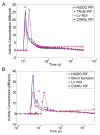Single-input-dual-output modeling of image-based input function estimation
- PMID: 19949986
- PMCID: PMC4286178
- DOI: 10.1007/s11307-009-0273-5
Single-input-dual-output modeling of image-based input function estimation
Abstract
Purpose: Quantification of small-animal positron emission tomography (PET) images necessitates knowledge of the plasma input function (PIF). We propose and validate a simplified hybrid single-input-dual-output (HSIDO) algorithm to estimate the PIF.
Procedures: The HSIDO algorithm integrates the peak of the input function from two region-of-interest time-activity curves with a tail segment expressed by a sum of two exponentials. Partial volume parameters are optimized simultaneously. The algorithm is validated using both simulated and real small-animal PET images. In addition, the algorithm is compared to existing techniques in terms of area under curve (AUC) error, bias, and precision of compartmental model micro-parameters.
Results: In general, the HSIDO method generated PIF with significantly (P < 0.05) less AUC error, lower bias, and improved precision of kinetic estimates in comparison to the reference method.
Conclusions: HSIDO is an improved modeling-based PIF estimation method. This method can be applied for quantitative analysis of small-animal dynamic PET studies.
Figures


Similar articles
-
An improved optimization algorithm of the three-compartment model with spillover and partial volume corrections for dynamic FDG PET images of small animal hearts in vivo.Phys Med Biol. 2018 Feb 26;63(5):055003. doi: 10.1088/1361-6560/aaac02. Phys Med Biol. 2018. PMID: 29480159 Free PMC article.
-
Spillover and partial-volume correction for image-derived input functions for small-animal 18F-FDG PET studies.J Nucl Med. 2008 Apr;49(4):606-14. doi: 10.2967/jnumed.107.047613. Epub 2008 Mar 14. J Nucl Med. 2008. PMID: 18344438
-
Image-derived and arterial blood sampled input functions for quantitative PET imaging of the angiotensin II subtype 1 receptor in the kidney.Med Phys. 2015 Nov;42(11):6736-44. doi: 10.1118/1.4934375. Med Phys. 2015. PMID: 26520763 Free PMC article.
-
Kinetic modeling in pre-clinical positron emission tomography.Z Med Phys. 2014 Dec;24(4):274-85. doi: 10.1016/j.zemedi.2014.02.003. Epub 2014 Mar 12. Z Med Phys. 2014. PMID: 24629308 Review.
-
PET kinetic analysis: error consideration of quantitative analysis in dynamic studies.Ann Nucl Med. 2008 Jan;22(1):1-11. doi: 10.1007/s12149-007-0083-2. Ann Nucl Med. 2008. PMID: 18250982 Review.
Cited by
-
Fully automated calculation of image-derived input function in simultaneous PET/MRI in a sheep model.EJNMMI Phys. 2016 Dec;3(1):2. doi: 10.1186/s40658-016-0139-2. Epub 2016 Feb 13. EJNMMI Phys. 2016. PMID: 26872658 Free PMC article.
-
Improved derivation of input function in dynamic mouse [18F]FDG PET using bladder radioactivity kinetics.Mol Imaging Biol. 2013 Aug;15(4):486-96. doi: 10.1007/s11307-013-0610-6. Mol Imaging Biol. 2013. PMID: 23322346 Free PMC article.
-
Noninvasive estimation of the arterial input function in positron emission tomography imaging of cerebral blood flow.J Cereb Blood Flow Metab. 2013 Jan;33(1):115-21. doi: 10.1038/jcbfm.2012.143. Epub 2012 Oct 17. J Cereb Blood Flow Metab. 2013. PMID: 23072748 Free PMC article.
-
Morning-evening variation in human brain metabolism and memory circuits.J Neurophysiol. 2013 Mar;109(5):1444-56. doi: 10.1152/jn.00651.2012. Epub 2012 Nov 28. J Neurophysiol. 2013. PMID: 23197455 Free PMC article.
-
Conditional Generative Adversarial Networks Aided Motion Correction of Dynamic 18F-FDG PET Brain Studies.J Nucl Med. 2021 Jun 1;62(6):871-879. doi: 10.2967/jnumed.120.248856. Epub 2020 Nov 27. J Nucl Med. 2021. PMID: 33246982 Free PMC article.
References
-
- Acton PD, Zhuang H, Alavi A. Quantification in PET. Radiol Clin North Am. 2004;42(6):1055–62. viii. - PubMed
-
- Wienhard K. Measurement of glucose consumption using [18F]fluorodeoxyglucose. Methods. 2002;27(3):218–225. - PubMed
-
- Fang YH, Muzic RF., Jr Spillover and Partial-Volume Correction for Image-Derived Input Functions for Small-Animal 18F-FDG PET Studies. J Nucl Med. 2008;49(4):606–614. - PubMed
-
- Laforest R, Sharp TL, Engelbach JA, et al. Measurement of input functions in rodents: challenges and solutions. Nucl Med Biol. 2005;32(7):679–85. - PubMed
-
- Gambhir SS, Schwaiger M, Huang SC, et al. Simple noninvasive quantification method for measuring myocardial glucose utilization in humans employing positron emission tomography and fluorine-18 deoxyglucose. J Nucl Med. 1989;30(3):359–66. - PubMed
Publication types
MeSH terms
Substances
Grants and funding
LinkOut - more resources
Full Text Sources
Other Literature Sources

